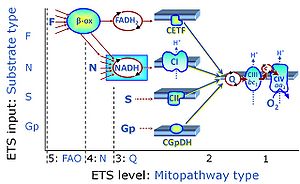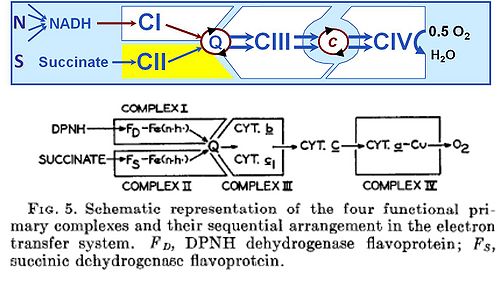Description
The Q-junction is a junction for convergent electron flow in the Electron transfer pathway (ET-pathway) from type N substrates and mt-matrix dehydrogenases through Complex I (CI), from type F substrates and FA oxidation through electron-transferring flavoprotein Complex (CETF), from succinate (S) through Complex II (CII), from glycerophosphate (Gp) through glycerophosphate dehydrogenase Complex (CGpDH), from choline through choline dehydrogenase, from dihydro-orotate through dihydro-orotate dehydrogenase, and other enzyme Complexes into the Q-cycle (ubiquinol/ubiquinone), and further downstream to Complex III (CIII) and Complex IV (CIV). The concept of the Q-junction, with the N-junction and F-junction upstream, provides the rationale for defining Electron-transfer-pathway states and categories of SUIT protocols.
Reference: Gnaiger 2009 Int J Biochem Cell Biol, Gnaiger 2020 BEC MitoPathways
MitoPedia concepts:
MiP concept,
SUIT concept
MitoPedia methods:
Respirometry
MitoPedia topics:
Enzyme
Contributed by Gnaiger E 2010-08-15; edited 2016-02-12, 2016-03-28.
- Convergent NS-linked electron flow at the Q-junction, exerting an additive effect on flux, versus electron gaiting for separation of single N- and S-input pathways (upper panel: Gnaiger 2009; lower panel: Hatefi 1962 J Biol Chem-XLII). Modified Figure in Gnaiger 2020 BEC MitoPathways.
Keywords
- Bioblast links: Q - >>>>>>> - Click on [Expand] or [Collapse] - >>>>>>>
- Coenzyme Q
- » Coenzyme Q
- » Quinone, Ubiquinone Q; oxidized
- » Quinol, Ubiquinol QH2; reduced
- » Semiquinone
- » Coenzyme Q2
- » Q-redox state
- » Q-pools
- Coenzyme Q
- Mitochondrial pathways, respiratory Complexes, and Q
- » Q-cycle
- » Q-junction
- » Convergent electron flow
- » NS-pathway
- » FNS
- » FNSGp
- Mitochondrial pathways, respiratory Complexes, and Q
- NextGen-O2k and Q-Module
SUITbrowser question: Q-junction
- Several SUIT protocols can be used to answer questions on additivity, or convergence of electron flow to the Q-junction.
- The SUITbrowser can be used to find the best SUIT protocols for different research questions, among those:


